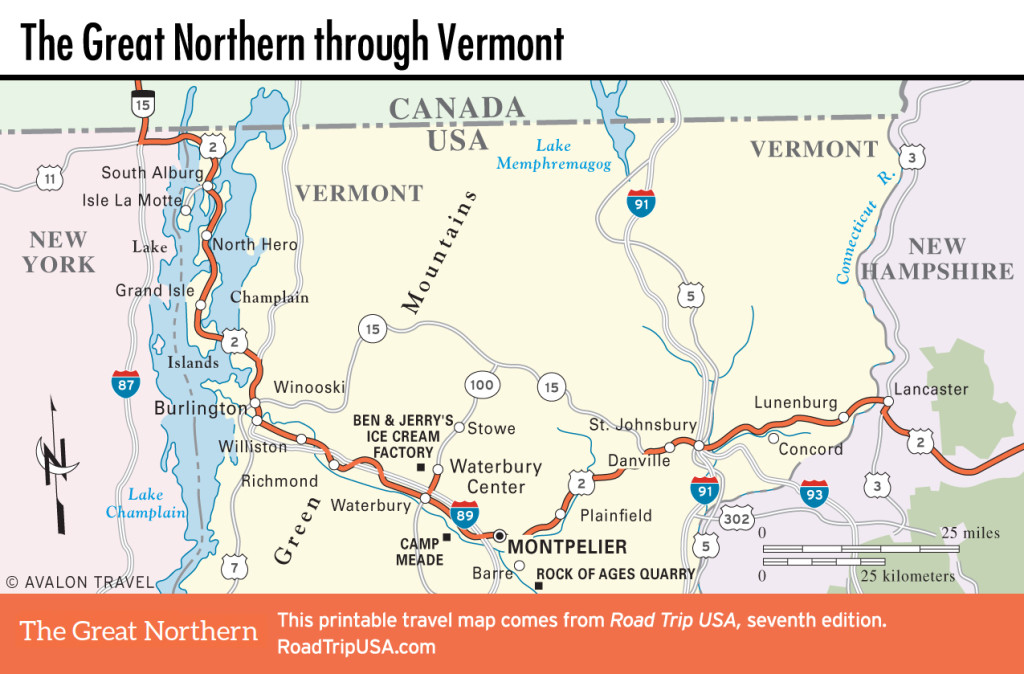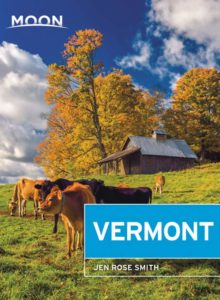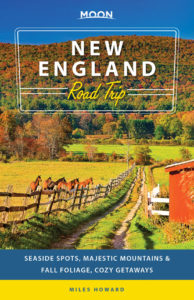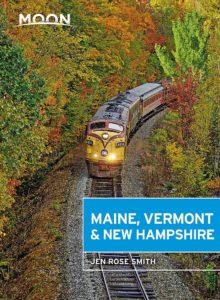Burlington
Best known these days as the home of Senator Bernie Sanders and countercultural icons Ben & Jerry’s, Burlington (pop. 42,899) has a long tradition of independent and creative thinking. After the original French settlers were ejected from the Lake Champlain region at the end of the French and Indian Wars, Ethan Allen, leader of the Green Mountain Boys band of guerrillas, and his brothers took over huge tracts of land and, resisting competing claims from New York and New Hampshire, established the independent Republic of Vermont. When Vermont joined the Union as the 14th state in 1791, Burlington boomed, aided by its strategic position on Lake Champlain, which was the quickest route between New York’s Hudson River and Montreal. While the political capital was established at nearby Montpelier, Burlington became the center of Vermont industry, finance, education, and culture—a position it has held ever since.
US-2/US-7 passes right through the center of town, following Winooski Avenue to the north, then along Main Street, lined by motels and restaurants on the outskirts but eventually crossing the lively, sprawling campus of the University of Vermont (UVM), which stands on a shallow hill on the east side of town. Along Colchester Avenue on the north edge of campus, the Fleming Museum of Art (802/656-0750, Tues.-Sun. Sept.-mid-May, $5) is the main visitor attraction, with a small but varied collection of fine and applied arts from ancient Egypt to the present.
Midway between Lake Champlain and the UVM campus, downtown Burlington is anchored by the Church Street Marketplace, a pedestrianized and increasingly chain-dominated shopping district that lies perpendicular to Main Street, north from Burlington’s stately old City Hall. From City Hall, Main Street continues west to Lake Champlain, where Waterfront Park has a strollable boardwalk linking up with Battery Park, home to a cannon pointing menacingly across the lake. In 1813, this cannon was used against British warships that bombarded the town. Bands frequently play here on summer evenings, and a bike path runs along the water. If you feel like getting out on the water, the Community Sailing Center north of the park rents kayaks, canoes and paddleboards. You can also hop a ferry across the lake to Port Kent, New York; or take a sunset cruise on board the Spirit of Ethan Allen (802/862-8300). Whatever you do, keep an eye out for Champ, Vermont’s version of the Loch Ness monster, who dwells deep in the waters of Lake Champlain.
Just south of Burlington is one of the nation’s great cultural institutions, the Shelburne Museum (802/985-3346, daily 10am-5pm May-Dec., Wed.-Sun. 10am-5pm Jan.-Apr., $10-25).
Where to Eat and Stay in Burlington
Downtown Burlington offers all the delights of a typical college town: bookstores, bars, international food, and trendy shopping. For food, two local favorites—the popular Penny Cluse Café (169 Cherry St., 802/651-8834) and The Daily Planet (15 Center St., 802/862-9647), behind Church Street—stand out among the many offerings around the Church Street Marketplace.
Thanks to the many students and Vermonters’ general love of live music, Burlington has some great nightclubs, ranging from the juke joint ambience of Nectar’s (188 Main St., 802/658-4771), where the band Phish was born and bred, to the high-style art deco Flynn Center for the Performing Arts (153 Main St., 802/863-5966 or 802/652-4500), across from City Hall, where bigger-name bands perform.
Places to stay, alas, don’t come particularly cheap, especially during peak leaf-peeping season, when run-of-the-mill rooms can cost $250 or more. The historic and central Willard Street Inn (349 S. Willard St., 802/651-8710 or 800/577-8712, $155 and up) is a nice B&B in an 1880s home, and some rooms have views of Lake Champlain. There are also many motels along US-7 south of downtown Burlington.
Related Travel Map

















